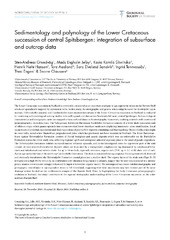| dc.contributor.author | Grundvåg, Sten-Andreas | |
| dc.contributor.author | Jelby, Mads Engholm | |
| dc.contributor.author | Śliwińska, Kasia Kamila | |
| dc.contributor.author | Nøhr-Hansen, Henrik | |
| dc.contributor.author | Aadland, Tore | |
| dc.contributor.author | Sandvik, Sara Elvelund | |
| dc.contributor.author | Tennvassås, Ingrid | |
| dc.contributor.author | Engen, Thea Marie | |
| dc.contributor.author | Olaussen, Snorre | |
| dc.date.accessioned | 2020-06-19T15:05:51Z | |
| dc.date.available | 2020-06-19T15:05:51Z | |
| dc.date.issued | 2019-06-27 | |
| dc.Published | Grundvåg SA, Jelby ME, Śliwińska KK, Nøhr-Hansen H, Aadland T, et al. Sedimentology and palynology of the Lower Cretaceous succession of central Spitsbergen: integration of subsurface and outcrop data. Norwegian Journal of Geology. 2019:99(2):253-284 | eng |
| dc.identifier.issn | 2387-5844 | en_US |
| dc.identifier.issn | 2387-5852 | en_US |
| dc.identifier.uri | https://hdl.handle.net/1956/22782 | |
| dc.description.abstract | The Lower Cretaceous succession in Svalbard is commonly considered as an important analogue to age-equivalent strata on the Barents Shelf which are sporadically targeted by exploration wells. In this study, the stratigraphic and genetic relationship between the Rurikfjellet (open marine), Helvetiafjellet (paralic) and Carolinefjellet (open marine) formations of the Lower Cretaceous succession in Svalbard is evaluated by combining sedimentological outcrop studies with well log and core data across Nordenskiöld Land, central Spitsbergen. Sedimentological characteristics and stratigraphic units are mapped within a refined dinocyst biostratigraphic framework, enabling relatively well-constrained palaeogeographic reconstructions. The Valanginian–lowermost Barremian Rurikfjellet Formation consists of a lower shale-dominated unit of offshore origin which grades upwards into storm-reworked lower shoreface sandstones displaying hummocky cross-stratification. Local occurrences of prodeltaic successions and thick successions of gravity flow deposits containing coal-bearing slump blocks of delta plain origin in some wells, reveal a late Hauterivian progradational pulse which has previously not been recorded in Svalbard. The lower Barremian– lower Aptian Helvetiafjellet Formation consists of fluvial braidplain and paralic deposits which rest unconformably on the Rurikfjellet Formation across the entire study area, reflecting regional uplift and widespread subaerial exposure prior to the onset of paralic deposition. The Helvetiafjellet Formation exhibits increased marine influence upwards, and in the investigated cores the uppermost part of the unit consists of wave-reworked mouth-bar deposits which are truncated by a transgressive conglomerate lag dominated by extrabasinal lithic clasts and intraformational siderite clasts. An up to 10 m-thick, regionally extensive, organic-rich (TOC up to 2.1 wt.%) shale unit of early Aptian age marks the base of the overlying Carolinefjellet Formation. The shale accumulated during a regional flooding event which drowned and eventually transformed the Helvetiafjellet Formation coastal plain into a shallow shelf. The organic facies of the shale unit (Type II–III kerogen) and a high Pr/Ph ratio (>2), in combination with abundant long-chained n-alkanes, suggest that the unit was deposited in a suboxic paralic marine environment strongly influenced by input of terrestrial organic matter. The investigated succession exhibits stratigraphic and petrographic resemblance to age-equivalent strata in NE Greenland, suggesting that these successions may have formed part of the same drainage system located on the northwestern margin of the Barents Shelf. Thus, by highlighting the Early Cretaceous palaeogeographic evolution in Svalbard, this study contributes to the regional stratigraphic understanding of the Lower Cretaceous succession on the wider northern Barents Shelf. | en_US |
| dc.language.iso | eng | eng |
| dc.publisher | Norsk Geologisk Forening | en_US |
| dc.rights | Attribution CC BY | eng |
| dc.rights.uri | http://creativecommons.org/licenses/by/4.0/ | eng |
| dc.subject | Svalbard | eng |
| dc.subject | northern Barents Shelf | eng |
| dc.subject | Mesozoic | eng |
| dc.subject | Early Cretaceous palaeogeography | eng |
| dc.subject | Facies analysis | eng |
| dc.subject | Sequence stratigraphy | eng |
| dc.title | Sedimentology and palynology of the Lower Cretaceous succession of central Spitsbergen: integration of subsurface and outcrop data | en_US |
| dc.type | Peer reviewed | |
| dc.type | Journal article | |
| dc.date.updated | 2019-11-06T07:01:07Z | |
| dc.description.version | publishedVersion | en_US |
| dc.rights.holder | Copyright 2019 The Author(s) | en_US |
| dc.identifier.doi | https://doi.org/10.17850/njg006 | |
| dc.identifier.cristin | 1734222 | |
| dc.source.journal | Norwegian Journal of Geology | |
| dc.relation.project | Norges forskningsråd: 228107 | |

